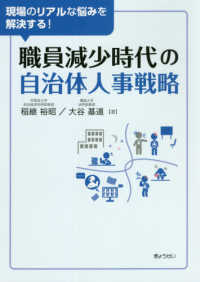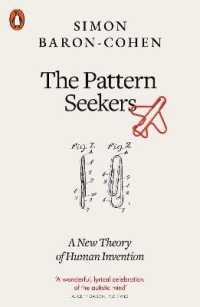Full Description
This open access book explores the potential of transdisciplinary, art-science approaches in addressing current social-ecological complexities within educational contexts. Moving beyond disciplinary perspectives this book integrates holistic, transdisciplinary approaches and creates spaces for imagining and co-creating just, liveable, healthy futures. As we face the urgent need for new ways of learning and engaging with nature, this volume emphasizes the importance of humans as integral parts of living systems. By fostering a regenerative and holistic perspective while improving wellbeing for humans and non-humans, the book offers tools and methods that invite learners to reimagine their relationships with nature and with the future.
It includes innovative approaches for community engagement, design, future visioning, experiential, embodied, and playful learning, providing a comprehensive resource for educators, community workers, policy makers, designers, scientists, architects, and urban planners. The book brings together creative, art-science approaches to advance transformative education in the field of sustainability science. Structured as a practical manual, it offers innovative methodologies with clear instructions for application in various learning environments.
Offering tutorials for 64 creative methods developed by the 124 authors from all around the world, this book offers a transdisciplinary and transcontextual approach making it relevant to a wide audience. This collaborative project is an output of the Cost Action CA21166 - Social Sciences and Humanities for Transformation and Climate Resilience (SHiFT) that brings together researchers and practitioners from different disciplines to address sustainability transformation.
Contents
Chapter 1. Daring Regenerative Futures: Embracing Change with Creative and Imaginative Approaches.- Chapter 2. Deliberative Futures Workshops for Transformative Sustainability.- Chapter 3. Collaborative Maps of Curiosity.- Chapter 4. Future and Nature Stakeholder Integration in Climate Deliberation.- Chapter 5. Building Communities in Action.- Chapter 6. Community Creativity Booster Method.- Chapter 7. Scale Shift & Mapping Drift: Transcalar Mapping for Participatory Planning.- Chpter 8. Enspirited Envisioning Approach.- Chapter 9. Creative Partnerships for the Regeneration of Urban Rivers.- Chapter 10. Foot(notes): A Walking Diary of Learning.- Chapter 11. Futures-inspired Embodied Transformation Theatre.- Chapter 12. A-lab Performed; Facilitating Aesthetic Exchange and Performance.- Chapter 13. "Circle of Life" Workshop: Where Nature, Art and Local Practices meet.- Chapter 14. Herbarium with Poetry: How to Connect People and Plants.- Chapter 15. Ecotheatre as a Tool of Environmental Imaginary.- Chapter 16. Ecostories for Children: An Art-Science Approach.- Chapter 17. The Inner Beauty of Art-Science Installations.- Chapter 18. Photography with Intervention.- Chapter 19. The Living Canvas: Community Mural Creation.- Chapter 20. The Echographic Poiesis Approach.- Chapter 21. Overcoming Otherness: An Artistic Approach.- Chapter 22. Future-oriented Creative Workshops.- Chapter 23. Narrating New Future Visions - Collective Storytelling about the Climate Crisis.- Chapter 24. Regenerative Futures with Children and Arts: The Radio Approach.- Chapter 25. Innovation Know-How Workshop.- Chapter 26. The BEEHIVE - Method to Explore Alternative Futures.- Chapter 27. Tales of Transformation: Working with Narratives for Climate-Just Futures.- Chapter 28. The Future You: Visioning and Empathising for Futures Literacy and Long-term Thinking.- Chapter 29. Imagination Activation Exercise: What If...?.- Chapter 30. Future Visioning as a Tool for Imagining Regenerative and Sustainable Futures.- Chapter 31. Sensing the City.- Chapter 32. Deep Time Walk.- Chapter 33. Building an Umwelt Apparatus.- Chapter 34. Eco-Sensory Learning Pathways for Neurodiverse Children.- Chapter 35. The Explorers in the Garden: Exploring our Natural Self and Restoring our Bonds with the Land.- Chapter 36. Connecting to Self and to Nature.- Chapter 37. Walking as Relational Aesthetics.- Chapter 38. Developing Daily Sustainable Habits.- Chapter 39. Perception Walks: Using Clothing as a Portal and Reflection as a Guide.- Chapter 40. The Permaculture Approach.- Chapter 41. Web-Based Application to foster Pro-Environmental Behaviour via Empathy.- Chapter 42. VROOM: A Group Activity for Sharing Energy, Maintaining Focus, and Encouraging Play.- Chapter 43. AROSA: Argumentative Role Play.- Chapter 44. Circular Families Game.- Chapter 45. Climate Community Street Play.- Chapter 46. Regen-D: Template-Based Games for Sustainability and Regeneration.- Chapter 47. Creating Social Change through Urban Gaming.- Chapter 48. A Listening Exercise in Care and Forgiveness.- Chapter 49. 'Reframing Perspectives': A Systems Mapping Exploration.- Chapter 50. Systems Sensing Approach.- Chapter 51. Exploring the Regenerative Potential of the Micro Level.- Chapter 52. Spatial Storytelling to mitigate Urban Sprawl.- Chapter 53. Sustainable Business Model Canvas.- Chapter 54. Integral Ecology: A Method for Education in addressing the Climate Crisis.- Chapter 55. Carbon Detox.- Chapter 56. More-than-human Future Ministries.- Chapter 57. Reflective Lifelines: Tracing the Path to Regenerative Horizons.- Chapter 58. Regenerative Practices, Teaching as Learning.- Chapter 59. Active Listening Workshop: The Art of Listening to Words and Emotions.- Chapter 60. Glocal Pedagogy.- Chapter 61. Asking Questions to co-create Future.- Chapter 62. Prebunking of Climate Change Conspiracy Theories.- Chapter 63. Effective Innovation Leadership Framework: Self-Reflection Method.- Chapter 64. Holistic Approach to Environmental Law Education.- Chapter 65. 3S: Seed, Save, Share.- Chapter 66. 3S: Seed, Save, Share.








